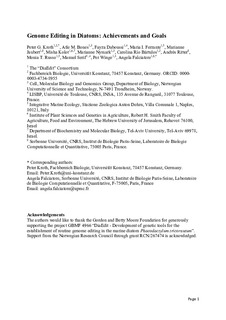Genome editing in diatoms: achievements and goals
Kroth, Peter G.; Bones, Atle M.; Daboussi, Fayza; Ferrante, Maria I.; Jaubert, Marianne; Kolot, Misha; Nymark, Marianne; Rio Bártulos, Carolina; Ritter, Andrés; Russo, Monia T.; Serif, Manuel; Winge, Per; Falciatore, Angela
Journal article, Peer reviewed
Accepted version

Åpne
Permanent lenke
http://hdl.handle.net/11250/2590892Utgivelsesdato
2018Metadata
Vis full innførselSamlinger
- Institutt for biologi [2575]
- Publikasjoner fra CRIStin - NTNU [38127]
Sammendrag
Diatoms are major components of phytoplankton and play a key role in the ecology of aquatic ecosystems. These algae are of great scientific importance for a wide variety of research areas, ranging from marine ecology and oceanography to biotechnology. During the last 20 years, the availability of genomic information on selected diatom species and a substantial progress in genetic manipulation, strongly contributed to establishing diatoms as molecular model organisms for marine biology research. Recently, tailored TALEN endonucleases and the CRISPR/Cas9 system were utilized in diatoms, allowing targeted genetic modifications and the generation of knockout strains. These approaches are extremely valuable for diatom research because breeding, forward genetic screens by random insertion, and chemical mutagenesis are not applicable to the available model species Phaeodactylum tricornutum and Thalassiosira pseudonana, which do not cross sexually in the lab. Here, we provide an overview of the genetic toolbox that is currently available for performing stable genetic modifications in diatoms. We also discuss novel challenges that need to be addressed to fully exploit the potential of these technologies for the characterization of diatom biology and for metabolic engineering.